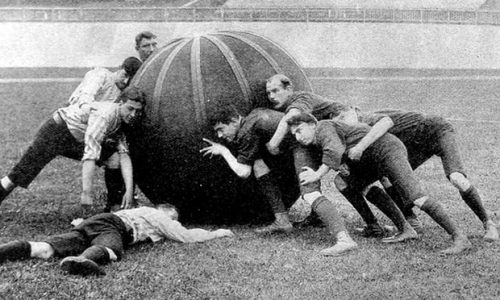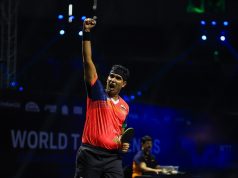A huge ball with a diameter of around 6 ft is placed in the middle of a field. Two opposing teams lines up on their individual goal lines on opposite ends of the field. At the sound of a whistle, each player of both the teams rush to the huge ball and try to push it into the opponent’s goal line. The team that is successful in scoring maximum goals wins the match. But what is that match? Did you ever see such a game in recent times? It was Pushball—one of the craziest-forgotten sports in American and British sporting history conceptualized in the late 19th century and became popular in the early 20th century. Its popularity was such that almost everyone, from students to bankers, from teachers to stockbrokers had thrown themselves at the Pushball.
 Pushball was the brainchild of Moses Crane, an electrical engineer of Massachusetts. Crane had three sons who played football at Harvard, but he was not a great supporter of the sport. He was particularly irritated by the fact of following the progress of a small ball as a spectator on a crowded football field. And so Crane thought of making the ball larger so that a player on one side could not see who was on the other. According to him that would make the spectators more interested in watching the whole game. In 1894 he invested some $175 to make a monster ball out of rubber and leather. The ball was six ft in diameter and weighed about 70 pounds. After some months of experimentation, Crane’s son Edwin produced some rules for the game and thus Pushball was born.
Pushball was the brainchild of Moses Crane, an electrical engineer of Massachusetts. Crane had three sons who played football at Harvard, but he was not a great supporter of the sport. He was particularly irritated by the fact of following the progress of a small ball as a spectator on a crowded football field. And so Crane thought of making the ball larger so that a player on one side could not see who was on the other. According to him that would make the spectators more interested in watching the whole game. In 1894 he invested some $175 to make a monster ball out of rubber and leather. The ball was six ft in diameter and weighed about 70 pounds. After some months of experimentation, Crane’s son Edwin produced some rules for the game and thus Pushball was born.
The official debut of Pushball came in October of 1885, during the halftime of a Harvard-Brown football match. It was a hit at its first stroke. A surprised New York Times reporter explained, “The object of the game is simply to push the ball. It appeared very much a game for strong, active men, but was very amusing to the spectators.” In the beginning, there were two halves. If a goal was scored quickly by one team, a second half was played. If neither side scored within the two ten-minutes halves allotted, the victory fell to the side which had kept the ball in the their opponent’s territory for the greater length of time.
The innovator of Pushball, Moses Crane died in 1898 and could not witness its growing popularity. The sport was accepted well by the Americans. Teams were to be made up of five forwards, two left wings, two right wings, and two goalies. The pitch was set at 120 by 50 yards, the same as a football field, with an H-shaped goal on each side. The players enjoyed the game and so the spectators. A popular series of sports manual at that time, Spalding’s Athletic Library, did an extensive research on Pushball with complete illustrations of the game. This research took the game much forward and within few years, Pushball extended to the mecca of sporting activities, Britain.
Though British Press acknowledged Pushball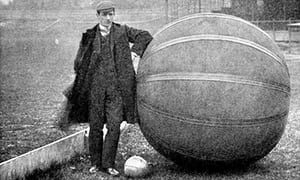 as “Yankee invention” in 1895, the game properly arrived in Britain in 1902. On 23rd August, it was played before a curious gathering of 4,004 spectators at Headingley. The 6ft ball used in the game was constructed from hides of nine horses, which took two and a half hours to inflate using a specially-modified pump. EV Hanegan, a British entrepreneur, was the promoter of the game in Britain. Before the first official match, Hanegan distributed leaflets among the crowd, suggesting that “league and rugby clubs will play this game throughout the summer months, thus keeping their players in the pink of condition.”
as “Yankee invention” in 1895, the game properly arrived in Britain in 1902. On 23rd August, it was played before a curious gathering of 4,004 spectators at Headingley. The 6ft ball used in the game was constructed from hides of nine horses, which took two and a half hours to inflate using a specially-modified pump. EV Hanegan, a British entrepreneur, was the promoter of the game in Britain. Before the first official match, Hanegan distributed leaflets among the crowd, suggesting that “league and rugby clubs will play this game throughout the summer months, thus keeping their players in the pink of condition.”
From Headingley, Pushball went on a nationwide British tour. In Hull, Halifax, Middlesbrough, Newcastle, Sheffield, Glasgow and Cork the game attracted thousands of people. 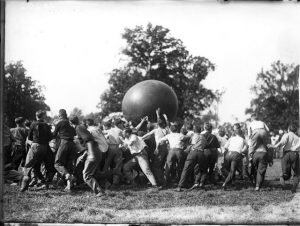 When a team managed to bear the ball above them towards their opponents’ goal it was entertaining to watch and the crowd cheered with delight. The Yorkshire Post said “though it is not as exciting as football, because the ball cannot be moved so quickly, there is nevertheless a fair scope for science and skill”. On September, 1902 the national tour of Britain concluded with a showpiece finale in London.
When a team managed to bear the ball above them towards their opponents’ goal it was entertaining to watch and the crowd cheered with delight. The Yorkshire Post said “though it is not as exciting as football, because the ball cannot be moved so quickly, there is nevertheless a fair scope for science and skill”. On September, 1902 the national tour of Britain concluded with a showpiece finale in London.
In 1912 new rules were laid down to make Pushball more result-oriented and interesting. The fight was divided into ten-minute quarters rather than halves. At the end of each quarter, two points were to be awarded to the side which placed the ball in the opponent’s territory. If the ball was pushed over the goal line, five points were to be awarded to the scoring side. But as it was physically too taxing for the players, Pushball was started to be played on horses. The ball was pushed by knees of the horses and expert riders often finished at the winning side. Mounted pushball became quite common in military tournaments for a while. According to sports historian John Thorn, some attempted Auto Pushball by the 1920s in which two teams of three cars went after the 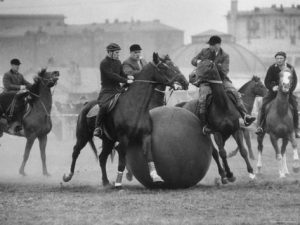 huge ball.
huge ball.
But gradually, Pushball lost its momentum as players started to take little interest in this lesser-known sport. Perhaps it was too strenuous and obviously dangerous. Even the spectators were bored by the decreasing thrill of the game. Facing anonymity, one of its last appearances in press came in 1927 when Guardian reported that the Duke of York joined in a game while visiting a holiday camp in New Romney. “The Duke was among those who were bowled over now and again,” Guardian reported. “He took it good-humouredly, and at the close of the play was taken to hospital to have a slight injury on his elbow treated.” The reason for its dying out was nicely summarized by historian Thorn. “I think the existential pointlessness of the game had to dawn upon its participants. You push this thing around, and then the time for your game is finished,” Thorn said.

